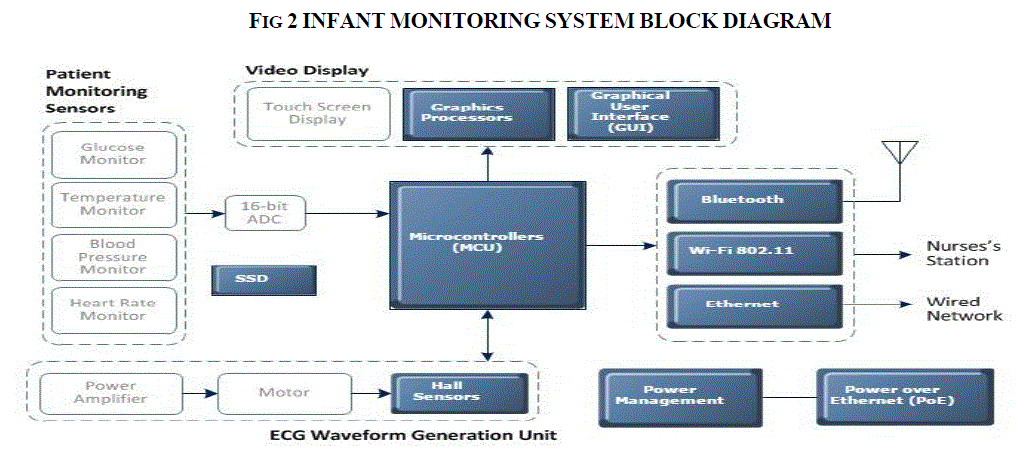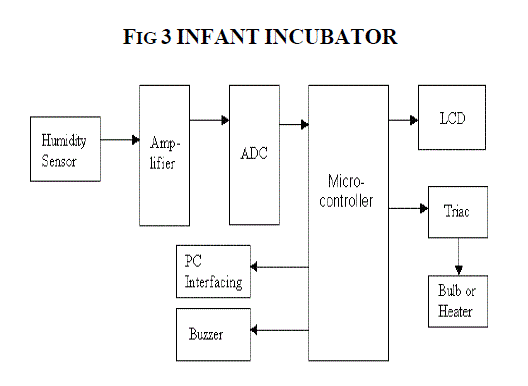ISSN ONLINE(2319-8753)PRINT(2347-6710)
ISSN ONLINE(2319-8753)PRINT(2347-6710)
Shijo Joseph Mathew 1, S. Mathankumar2, S.Vaishnodevi3
|
| Related article at Pubmed, Scholar Google |
Visit for more related articles at International Journal of Innovative Research in Science, Engineering and Technology
Newborn babies who need intensive medical attention are often admitted into a special area of the hospital called the Neonatal Intensive Care Unit (NICU). The NICU combines advanced technology and trained health care professionals to provide specialized care for the tiniest patients. Neonatal intensive care units can be created by all its features and functionality in a portable manner. All the features which ensure the growth, emergency and sustainable environment can be in cooperated within the prototype. By implementing the units they can be shifted to the wards/rooms by maintain all its sterilized environmental conditions
Keywords |
| Neonatal Intensive Care Unit (NICU), Nebulizer, Sensor, Warmer, jaundice |
INTRODUCTION |
| A NICU is typically directed by one or more neonatologists and staffed by nurses, nurse practitioners, pharmacists, physician assistants, resident physicians, and respiratory therapists. Many other ancillary disciplines and specialists are available at larger units. NICUs now concentrate on treating very small, premature, or congenitally ill babies. Some of these babies are from higher-order multiple births, but most are still single babies born too early. Premature labor, and how to prevent it, remains a perplexing problem for doctors. Even though medical advancements allow doctors to save low-birth-weight babies, it is almost invariably better to delay such births. The long-term outlook for premature babies saved by NICUs has always been a concern. From the early years, it was reported that a higher proportion than normal grew up with disabilities, including cerebral palsy and learning difficulties. Now that treatments are available for many of the problems faced by tiny or immature babies in the first weeks of life, long-term follow-up, and minimising long-term disability, are major research areas. The NICU environment provides challenges as well as benefits. Stressors for the infants can include continual light, a high level of noise, separation from their mothers, reduced physical contact, painful procedures, and interference with the opportunity to breastfeed. A NICU can be stressful for the staff as well. A special aspect of NICU stress for both parents and staff is that infants may survive, but with damage to the brain, lungs or eyes. |
II. SCOPE OF THE PROJECT |
| The birth of a baby is a wonderful yet very complex process. Many physical and emotional changes occur for mother and baby. A baby must make many physical adjustments to life outside the mother's body. Leaving the uterus means that a baby can no longer depend on the mother's circulation and placenta for important physiologic functions. Before birth, breathing, eating, elimination of waste, and immunologic protection all came from the mother. When a baby enters the world, many body systems change dramatically from the way they functioned during fetal life: ïÃâ÷ The lungs must breathe air. ïÃâ÷ The cardiac and pulmonary circulation changes. ïÃâ÷ The digestive system must begin to process food and excrete waste. ïÃâ÷ The kidneys must begin working to balance fluids and chemicals in the body and excrete waste. |
| ïÃâ÷ The liver and immunologic systems must begin functioning independently. Your baby's body systems must work together in a new way. Sometimes, a baby has difficulty making the transition to the world. Being born prematurely, having a difficult delivery, or birth defects can make these changes more challenging. Fortunately for these babies, special newborn care is available. Newborn babies who need intensive medical attention are often admitted into a special area of the hospital called the Neonatal Intensive Care Unit (NICU). The NICU combines advanced technology and trained health care professionals to provide specialized care for the tiniest patients. NICUs may also have intermediate or continuing care areas for babies who are not as sick but do need specialized nursing care. Some hospitals do not have the personnel or a NICU and babies must be transferred to another hospital. Some newborn babies will require care in a NICU, and giving birth to a sick or premature baby can be quite unexpected for any parent. Unfamiliar sights, sounds, and equipment in the NICU can be overwhelming. This information is provided to help you understand some of the problems of sick and premature babies. You will also find out about some of the procedures that may be needed for the care of your baby. Most babies admitted to the NICU are premature (born before 37 weeks of pregnancy), have low birth weight (less than 5.5 pounds), or have a medical condition that requires special care. In the U.S., nearly half a million babies are born preterm, and many of these babies also have low birth weights. Twins, triplets, and other multiples often are admitted to the NICU, as they tend to be born earlier and smaller than single birth babies. Babies with medical conditions such as heart problems, infections, or birth defects are also cared for in the NICU. The following are some factors that can place a baby at high risk and increase the chances of being admitted to the NICU. However, each baby must be evaluated individually to determine the need for admission. High-risk factors include the following: |
| Maternal factors Age younger than 16 or older than 40 years 1. Drug or alcohol exposure 2. Diabetes 3. Hypertension (high blood pressure) 4. Bleeding 5. Sexually transmitted diseases 6. Multiple pregnancy (twins, triplets, or more) 7. Too little or too much amniotic fluid 8. Premature rupture of membranes (also called the amniotic sac or bag of waters) |
| Delivery factors: |
| 1. Fetal distress/birth asphyxia (changes in organ systems due to lack of oxygen) 2. Breech delivery presentation (buttocks delivered first) or other abnormal presentation 3. Me conium (the baby's first stool passed during pregnancy into the amniotic fluid) 4. Nuchal cord (cord around the baby's neck) 5. Forceps or cesarean delivery |
| Baby factors: |
| 1. Birth at gestational age less than 37 weeks or more than 42 weeks 2. Birth weight less than 2,500 grams (5 pounds, 8 ounces) or over 4,000 grams (8 pounds, 13 ounces) 3. Small for gestational age 4. Medication or resuscitation in the delivery room 5. Birth defects 6. Respiratory distress including rapid breathing, grunting, or apnea (stopping breathing) 7. Infection such as herpes, group B streptococcus, chlamydia 8. Seizure |
| 9. Hypoglycemia (low blood sugar) 10. Need for extra oxygen or monitoring, intravenous (IV) therapy, or medications 11. Need for special treatment or procedures such as a blood transfusion |
III. PRESENT SITUATION AND NEEDS |
| The current technology that exist within the project is portable bilibalnket in which it is used to reduce the jaundice in the new born infants. A biliblanket is a portable phototherapy device for the treatment of neonatal jaundice (hyperbilirubinemia). BiliBlanket is a trademark of General Electric's Datex-Ohmeda subsidiary, but its name has become the generic, colloquial term for a range of similar products and the term used in the medical professions. The name is a combination of bilirubin and blanket. Other names used are home phototherapy system, bilirubin blanket, or phototherapy blanket. Biliblankets offer the possibility of treating some degrees of jaundice at home as long as the baby is otherwise healthy. This makes them quite popular with parents, doctors, and insurance companies, who would otherwise have to pay for more expensive inpatient treatment. Some also consider it a better option because the newborn does not have to be separated from the parents and does not need to lie alone in a box with his or her eyes covered. The baby is tied to the machine, unless they can wheel it around, and there is a stiff pad between the mother and baby. While this is an inconvenience, most see it as a lesser of two evils. Phototherapy for jaundice involves a blue/white light of varying intensity placed close to the skin or touching it through a special, light-permeable fabric. The whole setup consists of the light generator, termed the light box, the fibre-optic cable through which the light is carried and the light pad, which is a 25cmx13cm (10"x5") pad that's attached to the baby. Home phototherapy is not dangerous and reports suggesting that babies have been burned by biliblankets.Currently need includes machinery with all the technology that is available in-order the make the infant to maintain and sustain its growing environment. |
FIG 1 BLOCKS DIAGRAM |
 |
FIG 2 INFANT MONITORING SYSTEM BLOCK DIAGRAM |
 |
FIG 3 INFANT INCUBATOR |
 |
IV. PROPOSED METHOD |
| Conventional methods include separate features’ for separate modalities. If an infant is diagnose with low temperature and is in need of oxygen, the infant is kept in a warmer which is supplied with oxygen. The diagnosis of the infant is to be in a condition in which the infant is suffering for jaundice, the infant is kept in the Phototherapy machine. Hence, depending on the various diagnoses, the infant is subjected to be in the various machineries [V]. The proposed method how-ever, contains fully systematic feature in which all the need equipment is enclosed within the system. Whenever an infant is diagnosis with certain diseases or condition, the system can be only being activated for that particular condition. When each modality is being turned ON it checks the vital conditions of the infant to be needed or not. |
V. CONCLUSION |
| `The implementation of portable Neonatal Intensive Care Unit resulted in diagnose of temperature, warmer with oxygen, diagnose of jaundice Phototherapy machine. When the infant is diagnosis with certain diseases or condition, the system can be only being activated for that particular situation. When each modality is being turned ON it checks the vital conditions of the infant to be needed or not. |
References |
|